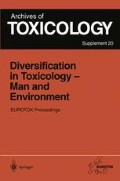Abstract
An essential step to protect human health from chemicals at the workplace or in the environment was to measure their concentration in the environment and to correlate them with adverse health effects. Tolerance values, like the maximum workplace concentrations (MAK-values), are established on that basis. A next step to improve exposure control was the introduction of human biomonitoring. Measuring the parent chemical or its stable metabolites in biological material, like blood or urine, allowed to assess the internal stress as compared to the external stress given by environmental monitoring. However, the biological activity of chemicals, of genotoxic carcinogens in particular, depends mostly on reactive intermediates generated in the course of metabolic activation. The biologically active dose cannot be assessed from stable metabolites usually measurable in biological metarial, but from the effects they produce. In contrast to „biomarkers of exposure“ the expression „biomarkers of response“ has been introduced. In this category two kinds of markers exist: biochemical effect markers and biological effect markers. The former markers are mainly protein and DNA adducts, the latter mutations, micronuclei, chromosomal aberrations or sister chromatid exchanges. Whereas the biochemical effects are not considered pathological per se, the biological effects can be seen one step further down to disease. However, as a dosimeter for the biologically active dose, adduct measurements are more specific and more sensitive than the biological endpoints. Moreover, they represent the strain of individuals best.
Access this chapter
Tax calculation will be finalised at checkout
Purchases are for personal use only
Preview
Unable to display preview. Download preview PDF.
References
Albrecht W, Neumann H-G (1985) Biomonitoring of aniline and nitrobenzene. Arch Toxicol 57: 1–5
Birner G, Albrecht W, Neumann H-G (1990) Biomonitoring of aromatic amines III: hemoglobin binding of benzidine and some benzidine congeners. Arch Toxicol 64:97–102
DFG (1996) Deutsche Forschungsgemeinschaft List of MAK and BAT Values 1996, Commission for the Investigation of Health Hazards of Chemical Compounds in the Work area, Report No 32, VCH Verlagsgesellschaft, Weinheim
Eyer P (1994) Reactions of oxidatively activated arylamines with thiols: reaction mechanisms and biological implications. An overview. Environ Health Perspec 102 (Suppl 6): 123–132
IARC (1989) IARC Monographs on the Evaluation of Carcinogenic Risk to Humans: Diesel and Gasoline Engine Exhausts and Some Nitroarenes. Vol 46, International Agency for Research on Cancer, Lyon
Leonhard TB, Graichen ME, Popp JA (1987) Dinitrotoluene isomer-specific hepatocarcinogenesis in F344 rats. J Nad Cancer Inst 79: 313–1319
Neumann H-G (1984) Analysis of hemoglobin as a dose monitor for alkylating and arylating agents. Arch Toxicol 56: 1–6
Neumann H-G, Albrecht O, van Dorp C, Zwirner-Baier I (1995) Macromolecular adducts caused by environmental chemicals. Clin Chem 41: 1835–1840
Neumann H-G, van Dorp C, Zwirner-Baier I (1995) The implications for risk assessment of measuring the relative contribution to exposure from occupation, environment and life-style: hemoglobin adducts from amino-and nitro arenes. Toxicol Letters 82 /83: 771–778
Sabbioni G, Wie J, Liu Y-Y (1996) Determination of hemoglobin adducts in workers exposed to 2,4,6-trinitrotoluene. J Chromatography B, 682: 243–248
Scheepers PT, Martens MH, Velders DD, Fijneman P, van Kerkhoven M, Noordhoek J, Bos RP (1995) 1-Nitropyrene as a marker for the mutagenicity of diesel exhaust-derived particulate matter in workplace atmospheres. Environ Mol Mutagen 25: 134–147
Stayner LT, Dannenberg AL, Bloom T, Thun M (1993) Excess hepatobiliary cancer mortality among munition workers exposed to dinitrotoluenes. J Occup Med. 35: 291–296
Suzuki J, Meguro S-I, Morita O, Hirayama S, Suzuki S (1989) Comparison of in vivo binding of aromatic nitro compounds to rat hemoglobin. Biochem Pharmacol 38: 3511–3519
van Dorp C (1997) Hämoglobinaddukte von Nitroaromaten als Dosimeter für die menschliche Beanspruchung durch Pyrolyseprodukte and Sprengstoffaltlasten, Thesis, Faculty of Chemistry and Pharmacy, University of Würzburg
Zwirner-Baier I, Neumann H-G (1994) Biomonitoring of aromatic amines IV: use of hemoglobin adducts to demonstrate the bioavailability of cleavage products from diarylide azo pigments in vivo. Arch Toxicol 68: 8–14
Zwirner-Baier I, Kordowich F-J, Neumann H-G (1994) Hydrolyzable hemoglobin adducts of polyfunctional monocyclic N-substituted arenes: dosimeters of exposure and markers of metabolism. Environ Health Perspec 102 (Suppl 6): 43–45
Author information
Authors and Affiliations
Editor information
Editors and Affiliations
Rights and permissions
Copyright information
© 1998 Springer-Verlag Berlin Heidelberg
About this paper
Cite this paper
Neumann, HG., Zwirner-Baier, I., van Dorp, C. (1998). Markers of Exposure to Aromatic Amines and Nitro-PAH. In: Seiler, J.P., Autrup, J.L., Autrup, H. (eds) Diversification in Toxicology — Man and Environment. Archives of Toxicology, vol 20. Springer, Berlin, Heidelberg. https://doi.org/10.1007/978-3-642-46856-8_16
Download citation
DOI: https://doi.org/10.1007/978-3-642-46856-8_16
Publisher Name: Springer, Berlin, Heidelberg
Print ISBN: 978-3-642-46858-2
Online ISBN: 978-3-642-46856-8
eBook Packages: Springer Book Archive

